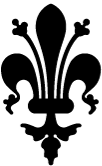Remediating ethnographica: how to make collections into the basis for new artistic research and production
Workshop with Clémentine Deliss, Luke Willis Thompson and Otobong Nkanga
The workshop is part of the project "Art, Space and Mobility in the Early Ages of Globalization: The Mediterranean, Central Asia and the Indian Subcontinent (MeCAIS) 400-1650"
organized by Hannah Baader, Avinoam Shalem and Gerhard Wolf
Thursday, 27th June
15.00-19.00
Kunsthistorisches Institut in Florenz - Max-Planck-Institut
Palazzo Grifoni Budini Gattai, Via dei Servi 51, 50122 Firenze
Lectures by Clémentine Deliss, Luke Willis Thompson and Otobong Nkanga
Friday, 28th June
10.00-14.00
Visits of Museo di Antropologia e Etnologia and Palazzo Pitti
15.00-17.00
Seminar & Discussion
Number of participants is limited on 28th therefore please contact Mirela Ljevakovic until June 20th if you wish to participate (mirela.ljevakovic@khi.fi.it)
What knowledge is produced and exchanged in an ethnographic museum in the 21st century? Who are today's aesthetic traders? Which objects and practices cut across time and create crossroads between former source cultures and new global routes? Creolising contexts, concepts of time, and systems of interpretation, the Weltkulturen Museum in Frankfurt sees its role today as that of a trading station of perception. Through a model of experimental remediation, it enables "objects in crisis to come in and out of power" (Luke Willis Thompson) multiplying the possibilities of knowledge production surrounding heritage collections from the 19th and 20th centuries.
At the Weltkulturen Museum's laboratory new 'prototypes' are developed by guest artists, designers, and writers in direct relation to the collection. These prototypes mirror the incompleteness and unfinished condition surrounding ethnographic artefacts. In reference to these objects from the past, new responses by artists act as both the generator and the narratological vehicle for contemporary interpretations. Prototypes are both the historical artefact itself and the new production, such that the conflation of both is the result of a dialogical work of assembling and remediating.
Dr. Clémentine Deliss, will talk about the model, methodology and experimentation that underpins this new form of post-ethnographic museum, and artists Otobong Nkanga (Nigeria/Berlin) and Luke Willis Thompson (Fiji/Auckland) will talk about their recent experiences at the Weltkulturen Museum. On the second day, the question of anachronism and display will be analysed on the basis of two case studies in museums in Florence.
Dr. Clémentine Deliss is Director of Weltkulturen Museum, Frankfurt am Main since April 2010. She studied contemporary art and social anthropology in Vienna, London, and Paris and holds a PhD (1988) from the School of Oriental and African Studies, University of London on 1920s French museum anthropology and dissident surrealism.
She has acted as a consultant for the European Union in Dakar and various cultural organizations, and conducted specific research projects through the support of art academies in Vienna, Glasgow, Bordeaux, Bergen, Copenhagen, Malmö, Stockholm, Edinburgh and London.
As an independent curator she has organized a number of exhibitions in Europe. From 1992 to 1995, she was the artistic director of Africa'95, an artist-led festival coordinated with the Royal Academy of Arts, London. In 1996, she created "Metronome", a magazine which moves to a different location each time, and as a result of the research of Metronome No.9, she established in 2005 a non-for profit publishing company with the co-founder Thomas Beautoux , called Metronome Press.
After object E1620: a ritual based approach to artistic research
Auckland-based artist Luke Willis Thompson will try to discuss the prototypical outcomes of his residency at the Weltkulturen Museum focusing on how the experience of being in residence in Frankfurt gave way to an unexpected latent site specificity that echoed former patterns of ethnographic practice.
Luke Willis Thompson (*1988 Auckland, NZ) lives and works in Auckland, NZ. His conceptual practice exists in both tangible and intangible forms. In recent work the artist has borrowed ready-made objects - such as a local funeral home's art collection and a black minstrel-style figure from an antique store - to trace the faultiness of race and class in his chosen context. Thompson's objects are often taken from sites of trauma or contain references to the artist's biography, but these are rarely made explicit. Thompson sets up estranging encounters where the viewer is invited to engage with a marginal object both ontologically and pushed into a fictional space of narrative and mythology.
Thompson graduated with an MFA from the University of Auckland's Elam School of Fine Arts in 2010. Recent solo exhibitions include: "inthisholeonthisislandwhereiam", Hopkinson Cundy, Auckland (2012); and "Yaw", RM, Auckland (2011). In 2012 Thompson's work was included in: "Between Memory and Trace", Te Tuhi, Pakuranga (2012); "Made Active: The Chartwell Show", Auckland Art Gallery Toi o Tamaki (2012); and "In Spite of Ourselves: Approaching Documentary", St Paul St Gallery, Auckland and Dowse Art Museum, Wellington (2012).Forthcoming exhibitions include "5th Auckland Triennial", Auckland Art Gallery (curated by Hou Hanru); "Octopus Show", Gertrude Contemporary, Melbourne (curated by Glenn Barkley); Solo Exhibition, Hopkinson Cundy, Auckland; "The Physics Room", Christchurch New Zealand.
He is represented by Hopkinson Cundy Gallery (hopkinsoncundy.com), Aukland, NZ.
Facing the Opponent: Fieldwork at the Weltkulturen Museum
Otobong Nkanga is one of seven artists who were invited in 2011 to live and work in the laboratory of the Weltkulturen Museum in Frankfurt, Germany. Professionally concerned with the relationships between perception and form, representation and craftsmanship, and with a pronounced awareness of visual and material culture, she selected artifacts from the ethnographic collection in order to produce new artworks in reference to this collection.
Nkanga's fieldwork in the museum focused on weapons, money, and jewelry from West and Central Africa. She chose artifacts whose functions overlap: a bronze bracelet can become a unit of monetary exchange, just as a weapon is also an accessory of prestige.
Otobong Nkanga will talk about her experiences: the discoveries, the challenges, the excitement and the emotions in working with those objects and subsequently the creation of new artworks as the results of this extraordinary residency.
Nigerian born artist Otobong Nkanga lives and works in Antwerp Belgium.
Her drawings, installations, photographs and sculptures variously examine ideas around land and the value connected to natural resources
In the work of Otobong Nkanga, activities and performance permeate all kinds of media and motivate photography, drawing, painting, sculpture, installation and video, though all the different works are thematically connected through architecture and landscape. As a human trace that testifies of ways of living and environmental issues, architecture and landscape act as a sounding board for narration and ‘the performative'. According to the artist herself, she uses her body and voice in live performances or in videos to become the protagonist in her work.
However, her presence serves mostly as a self-effacing catalyst, an invisible hand that sets the artistic process in motion. Nkanga negotiates the completion of the cycle of art between the aesthetic realm of display and a strategy of de-sublimation that repeatedly pushes the status of the artwork into contingency. In many of her works Nkanga reflects metonymically on the use and cultural value connected to natural resources, exploring how meaning and function are relative within cultures, and revealing different roles and histories for the same products, particularly within the context of the artist's autobiography and memories.
Nkanga's recent shows include: Sharjah Biennial 11, Sharjah, United Arab Emirates, (2013); Across the Board: Politics of Representation, Tate Modern, The Tanks, London, United Kingdom (2012); Inventing world: The Artist as citizen, Biennale Benin, Cotonou, Benin (2012); Tropicomania: The Social life of Plantes, Betonsalon, Center of art and research. Associated venue of La Triennale 2012 - Intense Proximity. Paris, France (2012); and Object Atlas - Fieldwork in the Museum, Weltkulturen Museum, Frankfurt-am-Main, Germany. (2012). ARS 11, Kiasma Museum of Contempoarary Art, Helsinki, Finland. (2011)
Scarica
Palazzo Grifoni Budini Gattai
Via dei Servi 51
50122 Firenze
Avviso
Questo evento viene documentato fotograficamente e/o attraverso riprese video. Qualora non dovesse essere d’accordo con l’utilizzo di immagini in cui potrebbe essere riconoscibile, da parte del Kunsthistorisches Institut in Florenz a scopo di documentazione degli eventi e di pubbliche relazioni (p.e. social media) la preghiamo gentilmente di comunicarcelo.


